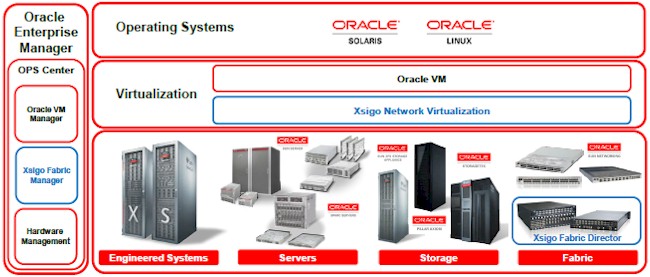This article is more than 1 year old
Oracle gussies up Xsigo switching as Virtual Networking and SDN
Lashes new Sparc T5 and M5 servers to each other and storage
Oracle is ratcheting up the virtual networking wars with the relaunch of its Xsigo line of I/O director switches.
Sun Microsystems made it clear years ago that it thought the future of data center networking was InfiniBand, and Oracle has followed along on that path by investing in Mellanox Technologies, which makes InfiniBand ASICs and switches, and perhaps more importantly by snapping up virtual I/O director maker Xsigo Systems last June for an undisclosed sum.
Now, Oracle is relaunching the Xsigo I/O director switches as its Virtual Networking product line and is extending the server-storage fabric to support its new Sparc T5 and M5 servers running Solaris.
Xsigo, which was founded in 2004, had a very simple idea: take an InfiniBand switch and plug an adapter into each server node that emulated an Ethernet network port for linking servers to each other and a Fibre Channel port for linking the server to storage and link it back to the Xsigo I/O director switch. Rather than needing multiple cables and host adapters, you could just use one per server and emulate Ethernet and Fibre Channel on top of InfiniBand. (This is an idea that was ahead of its time, obviously, when the first I/O director switch shipped in 2007 from Xsigo.)
Oracle is still selling the VP780 and VP560 fabric directors created by Xsigo, and has also slapped its brand on the Xsigo Server Fabric, a layer of abstraction that manages end-to-end connectivity for virtual machines in a pool of servers that Xsigo launched back in August 2011.
The latest I/O directors are based on Quad Data Rate (QDR) InfiniBand, which runs at 40Gb/sec, and the Xsigo server adapter card brings 80Gb/sec of bandwidth to each server node through one cable. The VP760 is now called the Oracle Fabric Interconnect F1-15, and the name is a reminder that it has up to 15 I/O modules that plug into the chassis to link from the I/O director switch out to storage arrays. The VP560 is called the Oracle Fabric Interconnect F1-4, again a reminder that it has only four I/O modules to link out to storage.
Oracle is sticking with the Xsigo bang-for-buck numbers, which claimed that by converging server and storage traffic over Xsigo I/O directors, companies could cut their networking and server adapter costs in half and buy 70 per cent fewer adapters and cables than they usually do to link servers to each other and to storage.

Where Xsigo – er, Network Virtualization – slides into the Oracle stack
Support for Sparc T5 and M5 servers as well as the Solaris operating system that runs on them is new since Oracle took over Xsigo last summer. Oracle is also supporting its entry and midrange Sparc T4 systems with the fabric interconnect, and that's because it is not withdrawing the Sparc T4 machines from marketing, but rather is pitching them for workloads that are smaller than are appropriate for the new Sparc T5 machines, which have twice as many cores and twice as much main memory capacity.
With Fabric Manager 4.1 (PDF), the Solaris 11 operating system running on Sparc or x86 systems is supported on server nodes. Red Hat Enterprise Linux, Oracle Linux, and Microsoft Windows Server 2008 R2 were already supported. Oracle is not saying when – or if – it will support Windows Server 2012, but it seems likely, given the preference some customers have for Windows over Unix or Linux.
What Oracle wants to point out is that with eight of the Fabric Interconnect director switches, it can scale up to 1,000 of its Sparc T5-8 midrange machines and over 128,000 cores as an interconnected cluster. The Fabric Manager software can create up to 16,000 virtual private Layer 2 networks on such a cluster, which can be used for isolating multiple tenants in a cloud.
Oracle has, of course, rebranded this virtual private networking feature of the Xsigo software stack as – you guessed it – Oracle SDN (PDF). Everything is software-defined networking these days.
Oracle did not reveal pricing on all of this rebranded and Sparc-enabled Xsigo hardware and software, but it did say it was going to host a launch event on April 30 to go over how to integrated the Virtual Networking wares into Oracle systems. ®
